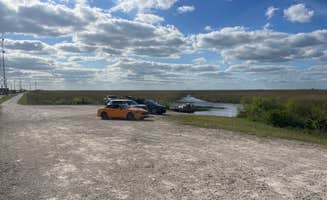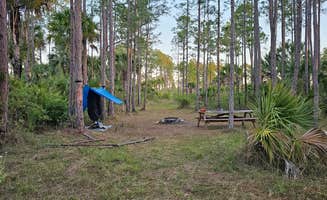Dispersed camping opportunities exist within 40-60 miles of Plantation, Florida, primarily in the wetland ecosystems of Big Cypress National Preserve. The preserve spans 720,000 acres of subtropical terrain with elevations rarely exceeding 8 feet above sea level. Seasonal water levels fluctuate significantly, affecting trail conditions and access to primitive campsites throughout the year.
What to do
Wildlife viewing opportunities: Big Cypress National Preserve offers excellent wildlife observation, particularly during winter months. At L-31 Boat Ramp, one visitor noted, "Bank fishing, no water, no services" but the area serves as a launch point for exploring nearby waterways.
Hiking on established trails: The Florida National Scenic Trail runs through multiple primitive camping areas. The Blue Trail provides access to Panther Camp, which one camper describes as "a tree grove with a picnic table and firepit. Large and maintained by the FTA, space for 10+ tents and hammocks."
Stargazing at select locations: While some areas suffer from light pollution, others offer better night sky viewing. When selecting free camping near Plantation, avoid sites with excessive artificial lighting. One camper warns about L-31: "There is a detention center across the highway, the lights from the canal crossing and water pump building are extremely bright, there is a huge lit up casino about 1/4 mile away."
What campers like
Complete disconnection: The primitive nature of these sites appeals to those seeking solitude. A camper at Carpenter Primitive Camp appreciates the "free camping with no facilities but plenty of space to set up tents or hammocks."
Budget-friendly options: No-cost camping near Plantation attracts those seeking economical outdoor experiences. One reviewer emphasized Panther Camp's accessibility: "I have hammock camped twice at this location. There is no cost to stay, no reservations needed. You can fill out a permit from the website."
Natural setting: Despite proximity to urban areas, these sites offer authentic wilderness experiences. The primitive camps provide natural surroundings with minimal development. Campers can observe native flora and fauna in their natural habitat, though they should maintain appropriate distance from wildlife.
What you should know
Permit requirements: Most dispersed sites in Big Cypress require permits obtained through the preserve's website. Always verify current requirements before arrival.
Water considerations: No potable water exists at primitive sites. Regarding Panther Camp's water source, one camper advises: "There is a water hole in the back of the camp which can be filtered. However a gator generally lives there. Better to pack your water in."
Access challenges: Seasonal conditions significantly impact trail accessibility. Some trails become impassable during wet periods. Verify current conditions with ranger stations before departure.
Light pollution issues: Some designated camping areas experience significant light intrusion. At Ivy Primitive Camp, campers report minimal light pollution compared to other sites in the region.
Tips for camping with families
Safety precautions: Always maintain wildlife awareness with children. Establish clear boundaries around camp and review wildlife safety protocols before arrival.
Distance considerations: Evaluate hiking distances when planning with children. The 5-mile hike to Panther Camp may challenge younger hikers. One reviewer noted, "The trail in can be muddy depending on the time of year. 5 miles from the entrance on the Blue Trail."
Communication planning: Cell service varies throughout the preserve. One camper mentioned Panther Camp has "Strong cell signal due to cell towers at the rest stop," which provides emergency communication capability.
Tips from RVers
Alternative options: Most dispersed camping near Plantation requires hiking access. RVs should consider established campgrounds instead of these primitive sites, which primarily accommodate tent and hammock camping.
Access limitations: L-31 Boat Ramp has two parking areas, but they aren't ideal for overnight stays. One reviewer observed: "There are two places to park, but one of them is right next to the pump building and down a steep hill."



